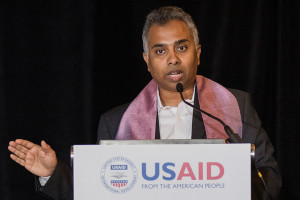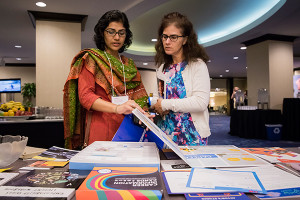DC Summit provides lessons on preventing school dropout
By Jennifer BrooklandOctober 2, 2015
Nearly 300 education and youth specialists, teachers, researchers and practitioners, and representatives from 12 ministries of education heard evidence and replicable options for addressing the global school dropout crisis at USAID and Creative Associates International’s School Dropout Prevention Summit.
The September event included a presentation of findings from one of USAID’s largest-ever impact evaluations, and panels that explored the issue of dropout both in the United States and internationally.
“Improving equitable access to education is certainly a challenge,” acknowledged Charles North, the Senior Deputy Administrator for USAID’s Bureau for Economic Growth, Education and Environment, at the opening of the School Dropout Prevention Summit. “But keeping those students in school is also a challenge. And that’s what we’re talking about today.”
Although a focus on access to education over the past 25 years has led to near-universal primary school enrollment in many countries, international attention has not been as focused on ensuring learning outcomes and completion, and school dropout has become an international pandemic.
Globally, 59 million children are out of school, and millions more are failing to learn, according to Albert Motivans, the head of Education Indicators and Data Analysis at the UNESCO Institute for Statistics. The rate of out of school children has not declined much in the past seven years and today it’s actually on the rise. Worldwide, 20 percent of out-of-school children of primary school age is a dropout.
As the Millennium Development Goals expire and the Sustainable Development Goals are launched, Motivans said dropout remains “unfinished business.”
Promising interventions

Over two days the School Dropout Prevention Summit explored the global issue of school dropout, implications of dropout on youth employability, crime and violence, gang membership, and gender considerations.
It also highlighted promising interventions, piloted as part of USAID’s School Dropout Prevention Pilot Program in Cambodia, India, Tajikistan and Timor-Leste. Implemented by Creative Associates International, the program included a low-cost early warning system that identifies at-risk students and enhances schools’ capacity to respond to their needs in partnership with families and communities, who are motivated and informed through open houses, home visits, phone calls and other outreach.
Data presented at the Summit showed these interventions, together with country-specific enrichment activities, were successful in boosting attendance in three of the four countries, and in lowering the dropout rate among at-risk students by 11.3 percent in Cambodia.
“Results from these randomized control trials are contributing to a body of knowledge about what schools, parents, communities and governments can put in place now to keep students from dropping out,” says Karen Tietjen, Principal Investigator for the School Dropout Prevention Pilot Program and Technical Director of Creative’s Education for Development Division.
They also underlined a key theme of the summit: the importance of community engagement in preventing dropout.
“Family and social support are probably the most important factors in who stays in school,” said panelist Stephanie Simmons Zuilkowski, an Assistant Professor at Florida State University. Her own research in post-conflict Sierra Leone confirmed that children were 45 percent less likely to drop out of school when they received more community and social support.
Supriya Bailey, an Assistant Professor at George Mason University, spoke about similar observations in India, Peru and Malawi, where girls who had support from their communities were more motivated to continue their educations.
In her closing remarks, USAID’s Senior Advisor for International Education Christy Vilsack emphasized the need for community responses as well. “We will never see significant improvement unless everyone pitches in,” she said.
Taking it home

Ministry of Education officials who attended the summit from other countries said they gained a greater understanding of the role of community engagement, and hoped to implement promising interventions such as Early Warning System they learned about during the event.
“There are symptoms before kids walk or are pushed out of school, but we’ve not taken much concern in that regard,” Sunday Mwape, District Education Board Secretary of Kabwe District in Zambia’s Central Province,Mwape says. “We should get beyond looking at students as a general cluster and look at them as individuals.”
“In our country, teachers are taught to teach content…They don’t know how to identify those kids before they drop out,” said Paulina Nkwama, a representative from the Prime Minister’s Office of Regional and Local Government in Tanzania, where a third of students drop out of primary school. Nkwama said she plans to request that teachers in Tanzania get more help to spot at-risk students.
By the close of the conference, Nkwama, Mwape and other Summit participants could already access tools that would help them do so.
An online learning lab where users can find tools, resources and take courses derived from the School Dropout Prevention Pilot Program’s experience, have virtual discussions and exchange best practices is now in place.
Officials, administrators, and anyone committed to addressing these critical challenges can use the lab to continue to collect and share evidence for what works in preventing dropout as they consider their options for making school a place where children can learn and stay.
Reporting contributed by J.C. Finley

